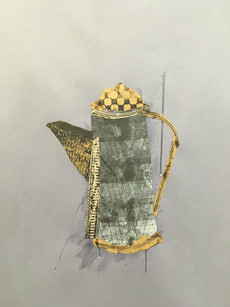A Cabinet of Curiosities: Drawing Objects in the Studio
- Jill Boualaxai
- Sep 17
- 2 min read
We all have objects we return to — not because they’re beautiful or important, but because they ask something of us when we draw them.
In the Look and Draw studio, there’s a shelf of well-worn favourites: an old studio heater, a cheese grater, a found beach toy, a twisted bit of rope, and a chipped vase discovered under the floorboards of my house. These aren’t precious things in the traditional sense. Some once were, others had a function and purpose but are now defunct or broken; some were treasures, now worn down by time. All are full of personality. Their chips and dents hold stories — of being broken, dropped, treasured, thrown aside, or lost.

The more you draw these objects, the more familiar they become. We’re not aiming for a picture-perfect copy. Instead, we explore how each object behaves — visually, physically, materially. A drawing becomes a kind of conversation, shaped through its tactile qualities: the weight of an object, its fragility, its sharpness or smoothness, its rough, worn, or scratched surface.

The permanence of ink or the softness of charcoal, the drag of a stick or the scratch of a wire — each tool leaves its own truth of the surface. A loop of wire might come out as a quick, scratchy line; charcoal dragged across the page can echo the roughness of metal. These small moments of contact — between object, eye, and hand — are where the drawing really lives, sometimes more revealing than any neat outline.
As Cy Twombly wrote, “Each line is now the actual experience with its own innate history. It does not illustrate — it is the sensation of its own realisation.” Drawing isn’t just a record of an object; it’s the trace of a moment lived.
When children draw, they don’t worry about getting things “right.” They follow their intuition, responding to what is in front of them. A drawing becomes less about what something looks like, and more about how it feels to encounter it. In the studio, we try to relearn this way of seeing, drawing objects from different directions and letting marks explore their surfaces rather than fixing them in a single view. A drawing becomes less about what something looks like, and more about how it feels to encounter it.

Over the years, participants at Look and Draw have returned to these objects again and again. The drawings are never the same. Some are careful studies, others bold, impulsive, or abstracted. Each holds something of the object, and something of the person who drew it.


























Comments